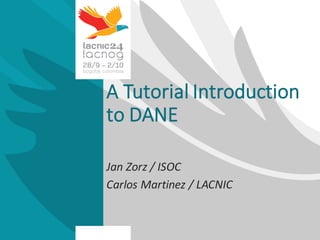
An Introduction to DANE - Securing TLS using DNSSEC
- 1. A Tutorial Introduction to DANE Jan Zorz / ISOC Carlos Martinez / LACNIC
- 2. Mechanics of Web Browsing • Security? 1. DNS query for www.google.com 2. TCP connection to IP obtained in (1) 3. Data flows in plain text Data flowing in plain text? That can be solved by encrypting the connection, right ? Enter TLS, Transport Layer Security
- 3. Securing and Authenticating Endpoints Application TLS Handshake TLS Record Protocol TCP IP Link and Physical Layers Application TLS Handshake TLS Record Protocol TCP IP Link and Physical Layers
- 5. Digital Certificates • A Public Key Certificate is a digital document that binds a set of information (fields) with a public key and is digitally signed. • Signatures can be either be performed by a third party or by the issuer itself (self-‐signed certificates) • Validation • Observers can verify the digital signature of the certificate • Trust • Certificate Authority model • Signature verification is followed up a chain until reaching a commonly agreed trust anchor
- 6. Digital Certificates (2) • Fields and flags in a certificate define how, where and when the certificate can be used and define is valid to be used • Valid-‐from, Valid-‐until times • Express constraints on usage • Extensions • Lists of [type-‐value-‐critical_flag] • Examples • Key usage • Extended key usage (clientAuth, serverAuth, emailProtection, ... ) • RFC 3779 (Internet number resources)
- 7. Trust Chain I’m Carlos S4 I’m LACNIC S3 Kpriv3 I’m the CA2 S2 Kpriv2 I’m the United Nations S1 Kpriv1 I’m Jan S7 I’m Go6Labs S6 Kpriv6 I’m the ISOC S5 Kpriv5 ● Certs are public ● Private keys are not published, but held by their owners and used for signing when needed ● A common root serves as the agreed trust anchor
- 8. Drawbacks of the CA-‐Based Chain • Trust anchors can (and have been) successfully attacked • DigiNotar, GlobalSign, DigiCert Malaysia are just some examples • The process that CAs use to validate information provided by customers can be subverted • CAs are slow to react when a certificate is compromised • The revocation process can be slow and is based on the concept of CRLs that have to be downloaded and are re-‐ created every few hours • [Check https://tools.ietf.org/html/draft-‐housley-‐web-‐pki-‐ problems-‐00 ]
- 9. The DigiNotar Debacle • [https://www.enisa.europa.eu/media/news-‐ items/operation-‐black-‐tulip]
- 10. Shortcomings of the Traditional CA Model • The attack surface is huge and growing! • A CA can sign for ANY domain, and for the browser it’s enough to find one CA vouching for a given combination of domain and IP This is the list of TAs trusted by default by the latest version of Firefox.
- 11. And there is one hole more... • Any web browsing starts with a DNS query 1. DNS query for www.google.com 2. TCP connection to IP obtained in (1) 3. Hopefully, SSL handshake 4. Data flows Even if all the certificates and SSL servers are configured perfectly, there is still at least one insecure DNS query Enabling DNSSEC for the server domain secures the query. Without DNSSEC no connection is fully secured even if all certificates look fine.
- 12. Enter DANE
- 13. To Keep in Mind • TLS secures communications, prevents eavesdropping, allows server identification • When a client (C) connects to a TLS-‐protected server (S): • S presents C with a X.509 certificate • C must check whether: • Does the certificate contain the correct server name? • Does the certificate contain the correct IP address? • Is the server certificate signed by a CA I trust ?
- 14. DANE – The TLSA DNS Record What if… I could publish my digital certificates in the DNS itself ? From this point we assume all DNS zones are DNSSEC-‐ signed.
- 15. DANE – The TLSA DNS Record ; Zone example.com - Signed with DNSSEC example.com IN SOA (...) IN NS …. IN DNSKEY ... www.example.com. IN A 10.0.0.1 _443._tcp.www.example.com. IN TLSA …. From this point we assume all DNS zones are DNSSEC-‐signed.
- 16. TLSA Record Overview • The TLSA DNS record is our friend! • Contains information binding keys or certificates to domain names and DNS zones • Four fields: • Certificate usage field • Selector field • Matching type field • DATA _443._tcp.www.example.com IN TLSA 3 1 1 DATA “3” - Certificate usage field “1” - Selector field “1” - Matching type field DATA - Depends on the values of the above
- 17. DANE Use Cases • Now the operator of a TLS-‐enabled server can: • publish a complete certificate on the DNS • refer in the DNS to a CA that can validate the certs within that domain
- 18. 1-‐Slide DANE HOW-‐TO • Sign your zone with DNSSEC • Configure ‘HTTPS’ in your web server • Create a digital certificate yourself using OpenSSL • Configure Apache or your web server of choice • Create TLSA records using ldns-‐dane • http://www.nlnetlabs.nl/projects/ldns/ • There are other tools out there, I just found this one to be easy to use • Add the TLSA records to your DNS zone and re-‐sign • Wait for TTLs to expire…. et voilá!
- 19. Browser Support Via Plugins • CZ.NIC has implemented a nice set of plugins for validating https connections with DANE and for validating DNSSEC
- 20. LACNICLabs Site Before DANE • Certificate is not trusted • It’s not signed by any known CA
- 21. LACNICLabs After DANE • Validated!
- 22. Drawbacks ? Sure… • There is a bit of a learning curve • Browser support, still in its infancy • Application support in general • Dependent on DNSSEC adoption
- 23. Thanks!
